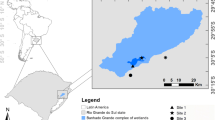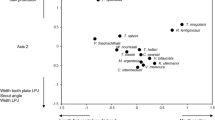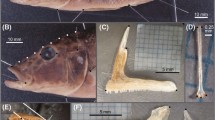Abstract
Cichlidae have a magnificent ecological versatility that provides the species to explore many trophic niches, and behavioural biology. This versatility was achieved by modifications in the cranial and pharyngeal apparatus of cichlids. Accordingly, we aim to examine the relationships between pharyngeal morphology and diet of three species of the genus Crenicichla. We analysed the stomach contents and the morphology (through the geometric morphometric and teeth types) of their lower pharyngeal jaws (LPJ). We tested the hypothesis that LPJ morphology predicts the diet of Crenicichla species in streams. Our results indicated that the diet and the patterns of pharyngeal jaws were different among the species of Crenicichla, mainly the posterior process of the LPJ, the region of muscle insertion of LPJs with the neurocranium and the curvature of LPJ. Variation among the lower pharyngeal jaw shapes was shown to be directly associated with the use of food resources. Crenicichla species had a carnivorous diet based on fish and invertebrates (Aegla and aquatic insects). Higher fish consumption was observed in species with elongated lateral process in the LPJ and larger numbers of teeth, mainly recurved and conical unicuspid and bicuspid teeth (C. scottii and C. lepidota). On the other hand, higher consumption of Aegla was associated with a robust LPJ and molariform teeth (C. punctata). The total number of teeth was positively correlated with higher fish consumption. In addition, our results point to the need for investigations about spatial-temporal variations in Crenicichla diets to understand this group’s success in several freshwater environments.






Similar content being viewed by others
References
Abell R, Thieme ML, Revenga C et al (2008) Freshwater ecoregions of the world: a new map of biogeographic units for freshwater biodiversity conservation. Bioscience 58:403–414. https://doi.org/10.1641/B580507
Adams DC, Otárola-Castillo E (2013) Geomorph: an R package for the collection and analysis of geometric morphometric shape data. Methods Ecol Evol 4:393–399. https://doi.org/10.1111/2041-210X.12035
Adams DC, Rohlf FJ (2000) Ecological character displacement in Plethodon: biomechanical differences found from a geometric morphometric study. Proc Natl Acad Sci 97:4106–4111. https://doi.org/10.1073/pnas.97.8.4106
Anderson MJ (2001) A new method for non-parametric multivariate analysis of variance. Austral Ecol 26:32–46. https://doi.org/10.1111/j.1442-9993.2001.01070.pp.x
Berbel-Filho WM, Martinez PA, Ramos TP, Torres RA, Lima SM (2016) Inter-and intra-basin phenotypic variation in two riverine cichlids from northeastern Brazil: potential eco-evolutionary damages of Sao Francisco interbasin water transfer. Hydrobiologia 766(1):43–56. https://doi.org/10.1007/s10750-015-2440-9
Binning SA, Chapman LJ (2010) Is intraspecific variation in diet and morphology related to environmental gradients? Exploring Liem’s paradox in a cichlid fish. Integr Zool 5:241–255. https://doi.org/10.1111/j.1749-4877.2010.00209.x
Bonato KO, Fialho CB (2016) Fishes of Alto Jacuí sub-basin: a poorly studied sub-basin of northwestern Rio Grande do Sul, Brazil. Check List 12(2):1867. https://doi.org/10.15560/12.2.1867
Bonato KO, Burress ED, Fialho CB (2017) Dietary differentiation in relation to mouth and tooth morphology of a neotropical characid fish community. Zool Anz 267:31–40. https://doi.org/10.1016/j.jcz.2017.01.003
Bookstein FL (1996) Combining the tools of geometric morphometrics. In: Marcus LF, Corti M, Loy A, Naylor GJP, Slice DE (eds) Advances in morphometrics. Springer, pp 131–151
Burress ED (2016) Ecological diversification associated with the pharyngeal jaw diversity of Neotropical cichlid fishes. J Anim Ecol 85(1):302–313. https://doi.org/10.1111/1365-2656.12457
Burress ED, Duarte A, Serra WS, Gangloff MM, Siefferman L (2013a) Species-specific ontogenetic diet shifts among Neotropical Crenicichla: using stable isotopes and tissue stoichiometry. J Fish Biol 82:1904–1915. https://doi.org/10.1590/1982-0224-20150151
Burress ED, Duarte A, Serra WS, Loureiro M, Gangloff MM, Siefferman L (2013b) Functional diversification within a predatory species flock. PLoS One 8(11):e80929. https://doi.org/10.1111/eff.12236
Burress ED, Duarte A, Serra WS, Loureiro M (2015) Rates of piscivory predict pharyngeal jaw morphology in a piscivorous lineage of cichlid fishes. Ecol Freshw Fish 25(4):590–598. https://doi.org/10.1111/eff.12236
Burress ED, Piálek L, Casciotta JR, Almirón A, Tan M, Armbruster JW, Rícan O (2017) Island- and lake-like parallel adaptive radiations replicated in rivers. Proc Biol Sci 285:20171762. https://doi.org/10.1098/rspb.2017.1762
Casciotta JR (1987) Crenicichla celidochilus n. sp. from Uruguay and a multivariate analysis of the lacustris group (Perciformes, Cichlidae). Copeia 1987(4):883–891
Casciotta JR, Arratia G (1993) Jaws and teeth of American cichlids (Pisces: Labroidei). J Morphol 217(1):1–36
Clarke KR (1993) Non-parametric multivariate analyses of changes in community structure. Austral Ecol 18:117–143. https://doi.org/10.1111/j.1442-9993.1993.tb00438.x
Cochran-Biederman JL, Winemiller KO (2010) Relationships among habitat, ecomorphology and diets of cichlids in the Bladen River, Belize. Environ Biol Fish 88(2):143–152. https://doi.org/10.1007/s10641-010-9624-y
Dala-Corte RB, Giam X, Olden JD, Becker FG, Guimarães TDF, Melo AS (2016) Revealing the pathways by which agricultural land-use affects stream fish communities in south Brazilian grasslands. Freshw Biol 61(11):1921–1934. https://doi.org/10.1111/fwb.12825
Elmer KR, Kusche H, Lehtonen TK, Meyer A (2010) Local variation and parallel evolution: morphological and genetic diversity across a species complex of neotropical crater lake cichlid fishes. Philos Trans R Soc Lond Ser B Biol Sci 365(1547):1763–1782. https://doi.org/10.1098/rstb.2009.0271
Fox J, Weisberg S (2019) An R companion to applied regression, 3rd edn. Sage, Thousand Oaks https://socialsciences.mcmaster.ca/jfox/Books/Companion/
Greenwood PH (1965) Environmental effects on the pharyngeal mill of a cichlid fish, Astatoreochromis alluaudi, and their taxonomic implications. Proc Linn Soc Lond 176(1):1–10
Harrell Jr FE (2019) with contributions from Charles Dupont and many others (2019) Hmisc: Harrell Miscellaneous. R package version 4.2–0. https://CRAN.R-project.org/package=Hmisc
Hellawell JM, Abel R (1971) A rapid volumetric method for the analysis of the food of fishes. J Fish Biol 3:29–37
Hellig CJ, Kerschbaumer M, Sefc KM, Koblmüller S (2010) Allometric shape change of the lower pharyngeal jaw correlates with a dietary shift to piscivory in a cichlid fish. Naturwissenschaften 97(7):663–672. https://doi.org/10.1007/s00114-010-0682-y
Huie JM, Summers AP, Kolmann MA (2019) Body shape separates guilds of rheophilic herbivores (Myleinae: Serrasalmidae) better than feeding morphology. J Acad Nat Sci Phila 166:1–15. https://doi.org/10.1635/053.166.0116
Hulsey CD (2006) Function of a key morphological innovation: fusion of the cichlid pharyngeal jaw. Proc Biol Sci 273(1587):669–675. https://doi.org/10.1098/rspb.2005.3375
Hulsey CD, Gracia de León FJ (2005) Cichlid jaw mechanics: linking morphology to feeding specialization. Funct Ecol 19:487–494. https://doi.org/10.1111/j.1365-2435.2005.00987.x
Hulsey DC, Roberts RJ, Lin AS, Guldberg R, Streelman TJ (2008) Convergence in a mechanically complex phenotype: detecting structural adaptations for crushing in cichlid fish. Evolution 62(7):1587–1599. https://doi.org/10.1111/j.1558-5646.2008.00384.x
Hyslop EJ (1980) Stomach contents analysis - a review of methods and their application. J Fish Biol 17:411–429
Jackson DA (1993) Stopping rules in principal components analysis: a comparison of heuristical and statistical approaches. Ecology 74(8):2204–2214
Kerschbaumer M, Sturmbauer C (2011) The utility of geometric morphometrics to elucidate pathways of cichlid fish evolution. Int J Evol Biol 2011:290245. https://doi.org/10.4061/2011/290245
Klingenberg CP (2010) Evolution and development of shape: integrating quantitative approaches. Nat Rev Genet 11(9):623–635. https://doi.org/10.1038/nrg2829
Klingenberg CP (2016) Size, shape, and form: concepts of allometry in geometric morphometrics. Dev Genes Evol 226(3):113–137. https://doi.org/10.1007/s00427-016-0539-2
Kullander SO, Lucena CAS (2006) A review of the species of Crenicichla (Teleostei: Cichlidae) from the Atlantic coastal rivers of southeastern Brazil from Bahia to Rio Grande do Sul states, with descriptions of three new species. Neotrop Ichthyol 4(2):127–146. https://doi.org/10.1590/S1679-62252006000200001
Lance RF, Kennedy ML, Leberg PL (2000) Classification bias in discriminant function analyses used to evaluate putatively different taxa. J Mammal 81:245–249. https://doi.org/10.1644/1545-1542(2000)081<0245:CBIDFA>2.0.CO;2
Liem KF (1973) Evolutionary strategies and morphological innovations: cichlid pharyngeal jaws. Syst Zool 22(4):425–441
Lobón-Cerviá J, Utrilla CG, Querol E, Puig MA (2005) Population ecology of pike-cichlid, Crenicichla lepidota, in two streams of the Brazilian Pampa subject to a severe drought. J Fish Biol 43(4):537–557. https://doi.org/10.1111/j.1095-8649.1993.tb00438.x
Lopez-Fernández H, Honeycutt RL, Winemiller KO (2005) Molecular phylogeny and evidence for an adaptive radiation of geophagine cichlids from South America (Perciformes: Labroidei). Mol Phylogenet Evol 34(1):227–244. https://doi.org/10.1016/j.ympev.2004.09.004
López-Fernández H, Winemiller KO, Montaña C, Honeycutt RL (2012) Diet-morphology correlations in the radiation of south American geophagine cichlids (Perciformes: Cichlidae: Cichlinae). PLoS One 7(4):e33997. https://doi.org/10.1371/journal.pone.0033997
López-Fernández H, Arbour J, Willis S, Watkins C, Honeycutt RL, Winemiller KO (2014) Morphology and efficiency of a specialized foraging behavior, sediment sifting, in neotropical cichlid fishes. PLoS One 9(3):e89832. https://doi.org/10.1371/journal.pone.0089832
Malabarba MC, Malabarba LR, López-Fernández H (2014) On the Eocene cichlids from the lumbrera formation: additions and implications for the Neotropical ichthyofauna. J Vertebr Paleontol 34(1):49–58. https://doi.org/10.1080/02724634.2013.830021
Muschick M, Barluenga M, Salzburger W, Meyer A (2011) Adaptive phenotypic plasticity in the Midas cichlid fish pharyngeal jaw and its relevance in adaptive radiation. BMC Evol Biol 11:116. https://doi.org/10.1186/1471-2148-11-116
Neff NA, Marcus LF (1980) A survey of multivariate methods for systematics. American Museum of Natural History, New York
Nelson JS (2006) Fishes of the world, 4th edn. Wiley, Hoboken
Neves MP, Da Silva JC, Baumgartner D, Baumgartner G, Delariva RL (2018) Is resource partitioning the key? The role of intra-interspecific variation in coexistence among five small endemic fish species (Characidae) in subtropical rivers. J Fish Biol 93(2):238–249. https://doi.org/10.1111/jfb.13662
Oksanen J, Kindt R, Legendre P, O’Hara B, Stevens MHH, Oksanen MJ (2019) The vegan package - community ecology package. R package version 2.0–9. https://CRAN.R-project.org/package=vegan
Olden JD, Jackson DA, Peres-Neto PR (2002) Predictive models of fish species distributions: a note on proper validation and chance predictions. Trans Am Fish Soc 131:329–336. https://doi.org/10.1577/1548-8659(2002)131<0329:PMOFSD>2.0.CO;2
Oliveira EF, Goulart E, Breda L, Minte-Vera CV, Paiva LRS, Vismara MR (2010) Ecomorphological patterns of the fish assemblage in a tropical floodplain: effects of trophic, spatial and phylogenetic structures. Neotrop Ichthyol 8:569–586. https://doi.org/10.1590/S1679-62252010000300002
Peres-Neto PR, Jackson DA, Somers KM (2005) How many principal components? Stopping rules for determining the number of non-trivial axes revisited. Comput Stat Data Anal 49(4):974–997. https://doi.org/10.1016/j.csda.2004.06.015
R Core Team (2019) R: a language and environment for statistical computing. R Foundation for Statistical Computing, Vienna, Austria. https://www.R-project.org/
Rohlf FJ (1990) Morphometrics. Annu Rev Ecol Syst 21(1):299–316
Rohlf FJ (1998) On applications of geometric morphometrics to studies of ontogeny and phylogeny. Syst Biol 47(1):147–158
Rohlf FJ (2015) The tps series of software. Hystrix 26(1):9–12. https://doi.org/10.4404/hystrix-26.1-11264
Rohlf FJ, Slice D (1990) Extensions of the Procrustes method for the optimal superimposition of landmarks. Syst Biol 39(1):40–59
Sampaio ALA, Goulart E (2011) Ciclídeos neotropicais: ecomorfologia trófica. Oecol Aust 15(4):775–798. https://doi.org/10.4257/oeco.2011.1504.03
Schneider RF, Li Y, Meyer A, Gunter HM (2014) Regulatory gene networks that shape the development of adaptive phenotypic plasticity in a cichlid fish. Mol Ecol 23(18):4511–4526. https://doi.org/10.1111/mec.12851
Smith L, Chakrabarty P, Sparks JS (2008) Phylogeny, taxonomy, and evolution of Neotropical cichlids (Teleostei: Cichlidae: Cichlinae). Cladistics 24(5):625–641. https://doi.org/10.1111/j.1096-0031.2008.00210.x
Sparks JS, Smith W (2004) Phylogeny and biogeography of cichlid fishes (Teleostei: Perciformes: Cichlidae). Cladistics 20(6):501–517. https://doi.org/10.1111/j.1096-0031.2004.00038.x
Venables WN, Ripley BD (2002) Modern applied statistics with S, 4th edn. Springer, New York
Wainwright PC (2005) Functional morphology of the pharyngeal jaw apparatus. Fish Physiol 23:77–101
Wainwright PC, Osenberg CW, Mittelbach GG (1991) Trophic polymorphism in the pumpkinseed sunfish (Lepomis gibbosus Linnaeus): effects of environment on ontogeny. Funct Ecol 5(1):40–55. https://doi.org/10.2307/2389554
Wainwright PC, Smith WL, Price SA, Tang KL, Sparks JS, Ferry LA, Kuhn KL, Eytan RI, Near TJ (2012) The evolution of pharyngognathy: a phylogenetic and functional appraisal of the pharyngeal jaw key innovation in labroid fishes and beyond. Syst Biol 61(6):1001–1027
Wei T, Simko V (2017) R package “corrplot”: Visualization of a Correlation Matrix (Version 0.84). https://github.com/taiyun/corrplot
Winemiller KO, Kelso-Winemiller LC, Brenkert AL (1995) Ecomorphological diversification and convergence in fluvial cichlid fishes. In: Luczkovich JJ, Motta PJ, Norton SF, Liem KF (eds) Ecomorphology of fishes. Springer, Dordrecht, pp 235–261
Young RL (2013) Linking conceptual mechanisms and transcriptomic evidence of plasticity-driven diversification. Mol Ecol 22(17):4363–4365. https://doi.org/10.1111/mec.12467
Zelditch ML, Swiderski DL, Sheets HD (2012) Geometric morphometrics for biologists: a primer. Academic Press
Acknowledgements
We thank the colleagues of the Ichthyology Laboratory at the Universidade Federal do Rio Grande do Sul for their aid in the field; L.R. Malabarba and C. Lucena for help in identifying the species studied; and Coordenação de Aperfeiçoamento de Pessoal de Nível Superior (CAPES) is thanked for providing financial support. We thank to E. Burres and R. Maestri for the clarifications on the analyses of geometric morphometry.
Author information
Authors and Affiliations
Corresponding author
Ethics declarations
Fish samples were collected with authorization #34940 from register #3196382 from Instituto Chico Mendes de Conservação da Biodiversidade (ICMBio). This study was approved by Ethics Committee on Animal Use of the Universidade Federal do Rio Grande do Sul (Permit #24434) and was conducted in accordance with protocols in their ethical and methodological aspects, for the use of fish.
Conflict of interest
The authors declare that they have no conflict of interest.
Additional information
Publisher’s note
Springer Nature remains neutral with regard to jurisdictional claims in published maps and institutional affiliations.
Electronic supplementary material
ESM 1
(DOCX 1256 kb)
Rights and permissions
About this article
Cite this article
Kuhn, F., Neves, M.P., Bonato, K.O. et al. Relationship between diet and pharyngeal jaw morphology of Crenicichla species (Cichliformes: Cichlidae) in streams from Uruguay and Jacuí basins, Southern Brazil. Environ Biol Fish 103, 377–388 (2020). https://doi.org/10.1007/s10641-020-00963-y
Received:
Accepted:
Published:
Issue Date:
DOI: https://doi.org/10.1007/s10641-020-00963-y




